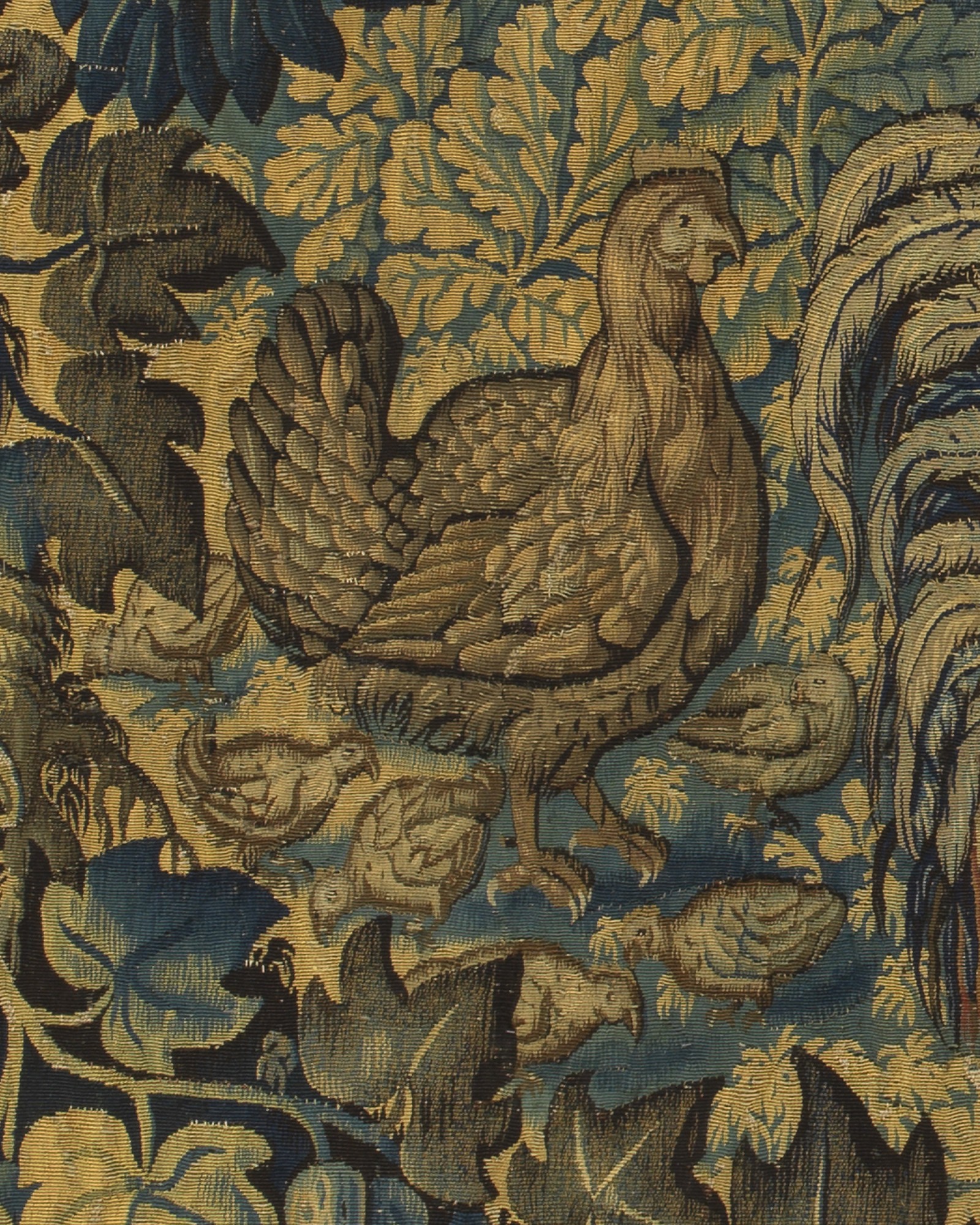


Private collection, Belgium, for more than 60 years
H. Goebel, Wandteppiche I: Die Niederlände (Klinkhardt & Biermann Verlag, Leipzig, 1923)
M. Roethlisberger, ‘La Tenture de la Licorne dans la Collection Borromée’ in Oud Holland, Vol. 82, Pt. 3 (1967), pp. 85, 107-108, 115
J. Szablowski (ed.), De Vlaamse wandtapijten van de Wawelburcht te Krakau (Mercatorfonds, Antwerpen, 1972), pp. 191-286
M. Ferrero-Viale, ‘Quelques nouvelles données sur les tapisseries de l'Isola Bella’ in Bulletin van de Koninklijke Musea voor Kunst en Geschiedenis, Vol. 45 (1973), pp. 77-142
P. Junquera de Vega, C. Díaz Gallegos, Catálogo de Tapices del Patrimonio Nacional, Vol. II, Siglo XVII (Patrimonio Nacional, Madrid, 1986)
J. Boccara, Ames de Laine et de Soie (Monelle Hayot, Saint-Just-en-Chaussée, 1988)
I. van Tichelen, Vijf eeuwen Vlaamse wandtapijtkunst (Taichung, Taipei, Mechelen, 1989), p. 36
I. de Meûter, M. Vanwelden, et al., Tapisseries d'Audenarde du XVIe au XVIIIe siècle (Éditions Lannoo, Tielt, 1999), pp. 140-141
E. Cleland, Grand Design: Pieter Coecke van Aelst and Renaissance Tapestry, exhibition catalogue (The Metropolitan Museum of Art, New York, 2014)
This superb tapestry belongs to a small group of works referred to as 'Verdues with Animals' or 'Parc Sauvages' ('Animal Parks'), some of which depict scenes of combat between wild beasts. Both the combative versions of these tapestries, which became known as ‘Pugnae Ferarum’ (‘Combat of the Wild Animals’), and the 'Parc Sauvages' examples, were inspired by the 16th century Southern Netherlandish painted landscapes of Gillis I of Coninckxloo and Hans Vredeman de Vries and integrate harmoniously a wide variety of both fantastic and real animals. Highly decorative, the present tapestry corresponds, both iconographically and stylistically, with the celebrated 44 16th century Brussels Verdue panels found in the Wawel Castle of Krakow designed by Pieter Coecke van Aelst of Antwerp and with the Verdure with Wild Animals in the Borromeo collection on Isola Bella in Lago Maggiore in Northern Italy attributed to Willem Tons of Brussels and believed to date from around 1565. The tapestries in the Borromeo collection convey a Messianic symbolism with an underlying theme of the Triumph of Christianity and Redemption of Man. They depict the Fall of Mankind at the Creation and Man’s salvation through the Passion of Christ.
This tapestry of wonderful colour shows a proud rooster and turkey with beautifully detailed feathers and full plumage on display. These two powerful animals, creating a focal point drawing the eye of the viewer, are set amongst a rich scene of woodland verdue filled with an abundence of animal and bird life. Set within the lower quarter of the interior panel, the two farm animals are surrounded by a chicken with her young, various birds of prey including owls, as well as ducks, parrots and cranes. Chicks, rabbits and turtles nestle within the foliage. Of particular signficance in this example of the genre is the inclusion of the exotic in the form of multiple monkeys – climbing vines, perched on branches with and without young, a group of new born huddled together amongst the leaves in the bottom left hand corner, one smiling cheekily at the viewer with an almost human-like expression. The same tree climbing monkey shown on the right hand side can be seen in a pen and brown ink drawing by Pieter Coecke van Aelst held in the British Museum (No. 1900.0613.1), a design for a tapestry which appears not to have survived.
The extraordinary variety of creatures interact in an exotic display against a backdrop of towns, villages, lakes, streams, hills and woodland comprised of an array of forms of flora. The complex composition and wide variety of densely placed animals, birds and foliage is indicative of the superior quality of this hanging. The entirely intact borders are decorated throughout with festoons of flowers and intertwined with allegorical and mythological figures and creatures including lizards, winged beasts, cats and birds of prey. As with our larger rectangle example from the same series, the upper left hand corner contains an eagle in flight with a snail in its claws. In a third related tapestry within our collection depicting a garden scene this representation appears in the upper right hand corner, versions of the same figures and creatures appearing around the border of that work.
This tapestry and our larger rectangle and garden examples are part of a series of verdues with the same or nearly same borders which are now in Torino, Palma and Le Mans. Near identical borders appear on the Story of Tobias tapestries (in the Museum Prisenhof in Delft) woven by the workshops of Jan Raes around 1600. A near identical tapestry is conserved in Le Chateau de Serrant in the Loire. Between 1580 and 1650 the Brussels workshops of Raes produced suites of tapestries for the most important private clients and heads of state. Three successive proprietors were named Jan, sometimes making it difficult to distinguish between them, but it was Jan Raes II (1570 – 1643) who was responsible for the animal series in question. The cartoons for these works were made after sketches by Jacob Savery (Courtai c.1545 – 1602 Amsterdam) who was known for his precise zoological observations.
This genre was very popular during the 16th and early 17th centuries and illustrates the contemporary fascination with the animal kingdom. The design was conceived to transport the viewer into an unfamiliar landscape where the sense of drama was greater than would have been experienced in the forests of Europe.